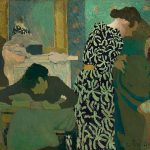
In 1892, he became a member of Les Nabis, a semi-secret, semi-mystical group of young artists, mostly from the Académie Julian, which included Pierre Bonnard, Ker-Xavier Roussel, Maurice Denis, and Édouard Vuillard, with whom Vallotton was to form a lifelong friendship. While the Nabis shared certain common ideas and goals, their styles were quite different and personal. He kept himself somewhat apart from the others, earning his jocular title among the Nabis as “The Foreign Nabi”. Vallotton’s paintings in this period reflected the style of his woodcuts, with flat areas of color, hard edges, and simplification of detail. His subjects included genre scenes, portraits and nudes. Examples of his Nabi style are the deliberately awkward Bathers on a Summer Evening (1892–93), now in the Kunsthaus Zürich, and the symbolist Moonlight (1895), in the Musée d’Orsay.
His paintings began to be noticed by the public and critics; Bathers on a Summer Evening, presented at the Salon des Indépendents, was met with harsh criticism and laughter. But his woodcuts attracted attention and clients, and he became financially secure. Between 1893 and 1897, he received many commissions for illustrations from notable French newspapers and magazines, including La Revue Blanche, and from foreign art publications, including The Chap-Book of Chicago. He also made woodcuts for the covers of theater programs and book illustrations. One of his prominent patrons was Thadée Natanson, the publisher of the Revue Blanche, and his wife Misia, who commissioned many important decorative works from the Nabis. Through the Natansons Vallotton was introduced to the avant-garde elite of Paris, including Stéphane Mallarmé, Marcel Proust, Eric Satie, and Claude Debussy.
His woodcut subjects included domestic scenes, bathing women, portrait heads, and several images of street crowds and demonstrations—notably, several scenes of police attacking anarchists. He usually depicted types rather than individuals, eschewed the expression of strong emotion, and “fuse[d] a graphic wit with an acerbic if not ironic humor”. Vallotton’s graphic art reached its highest development in Intimités (Intimacies), a series of ten interiors published in 1898 by the Revue Blanche, which deal with the tension between men and women. Vallotton’s woodcuts were widely disseminated in periodicals and books in Europe as well as in the United States, and have been suggested as a significant influence on the graphic art of Edvard Munch, Aubrey Beardsley, and Ernst Ludwig Kirchner.
In 1898 he bought a Kodak no.2 ‘Bullet’ and experimented with it as a basis for at least five interior paintings. His first photos were taken in: Chateau d’Etretat, Chateau de la Naz, the Natanson’s summer house above Cannes, and the Villa Beaulieu in Honfleur. Art historian Anca I Lasc suggests Woman in Blue Rummaging Through a Cupboard (1903) was based on a photograph taken in Vallotton’s own Paris home on Rue Milan or rue de Belles Feuilles. Therefore, his paintings were most likely based on real interiors.
Nabis Break Up
By 1900, the Nabis had drifted apart. One source of the division was the Dreyfus affair, the case of a Jewish army officer falsely accused of aiding the Germans. The Nabis were divided, with Vallotton passionately defending Dreyfus. He produced a series of satirical woodcuts on the affair, including The Age of the Newspaper, which was published on the first page of Le Cri de Paris on January 23, 1898, at the height of the affair.
Another major event during this period was his marriage in 1899 to Gabrielle Rodrigues-Hénriques, the widowed daughter of Alexandre Bernheim, one of the most successful art dealers in Europe and founder of the Galerie Bernheim-Jeune. The union brought to his household three children from her previous marriage.
There are few interiors by Vallotton that show children except for Dinner by Lamplight showing stepson Max, stepdaughter Madeline, with Gabrielle on his right with the back of the own artist’s head.
After a brief honeymoon in Switzerland, they moved to a large apartment near the Gare Saint-Lazare train station. The marriage brought him financial security, and he gradually abandoned woodcuts as his main source of income. He also established a solid relationship with the Bernheim family and their gallery, which presented a special exhibition devoted to the Nabis, including ten of his works. Thereafter he devoted his attention almost entirely to painting. Source: Wikipedia.




